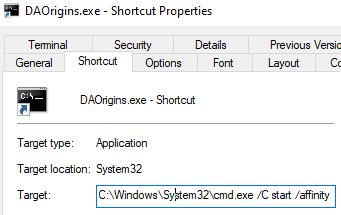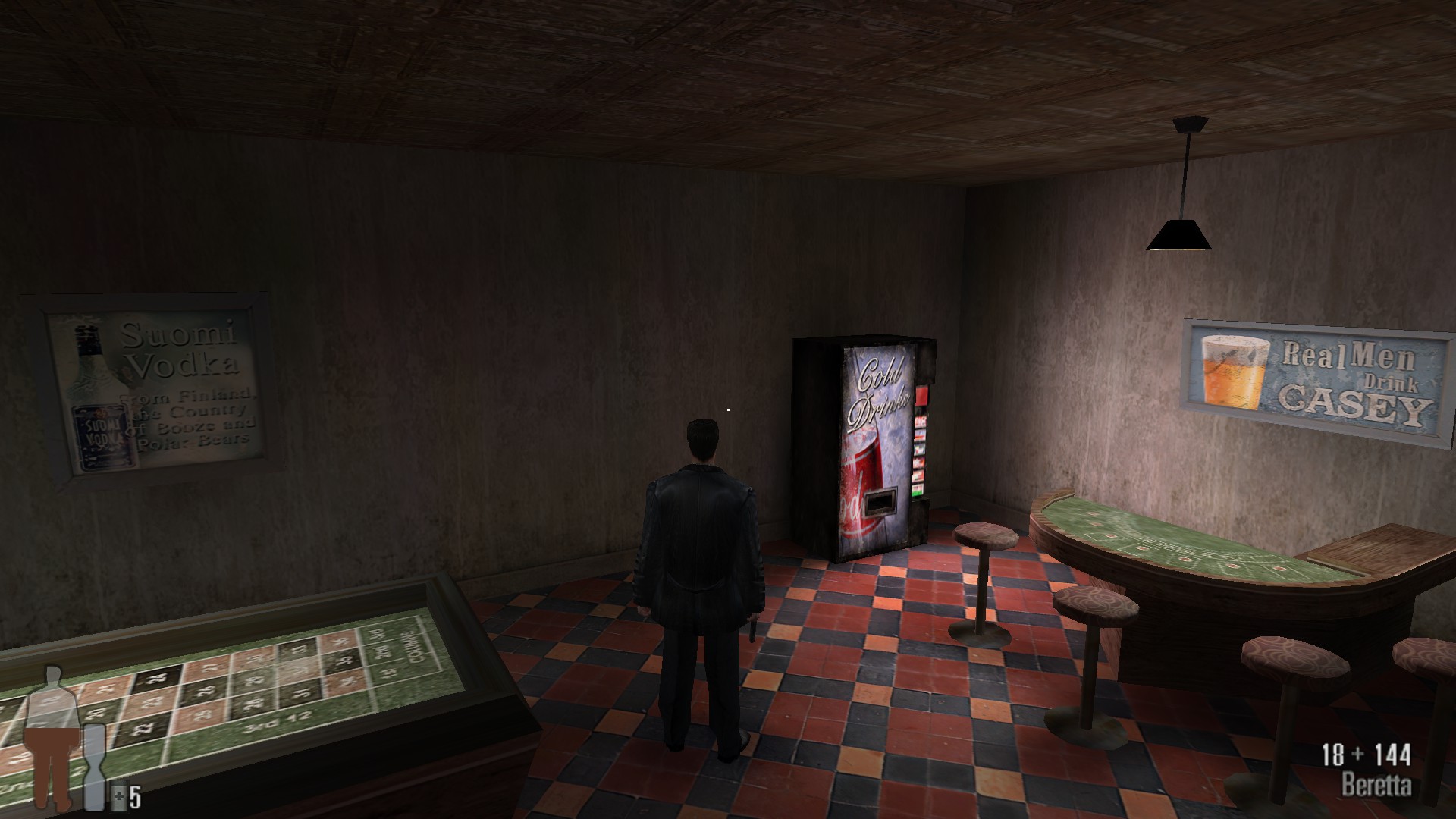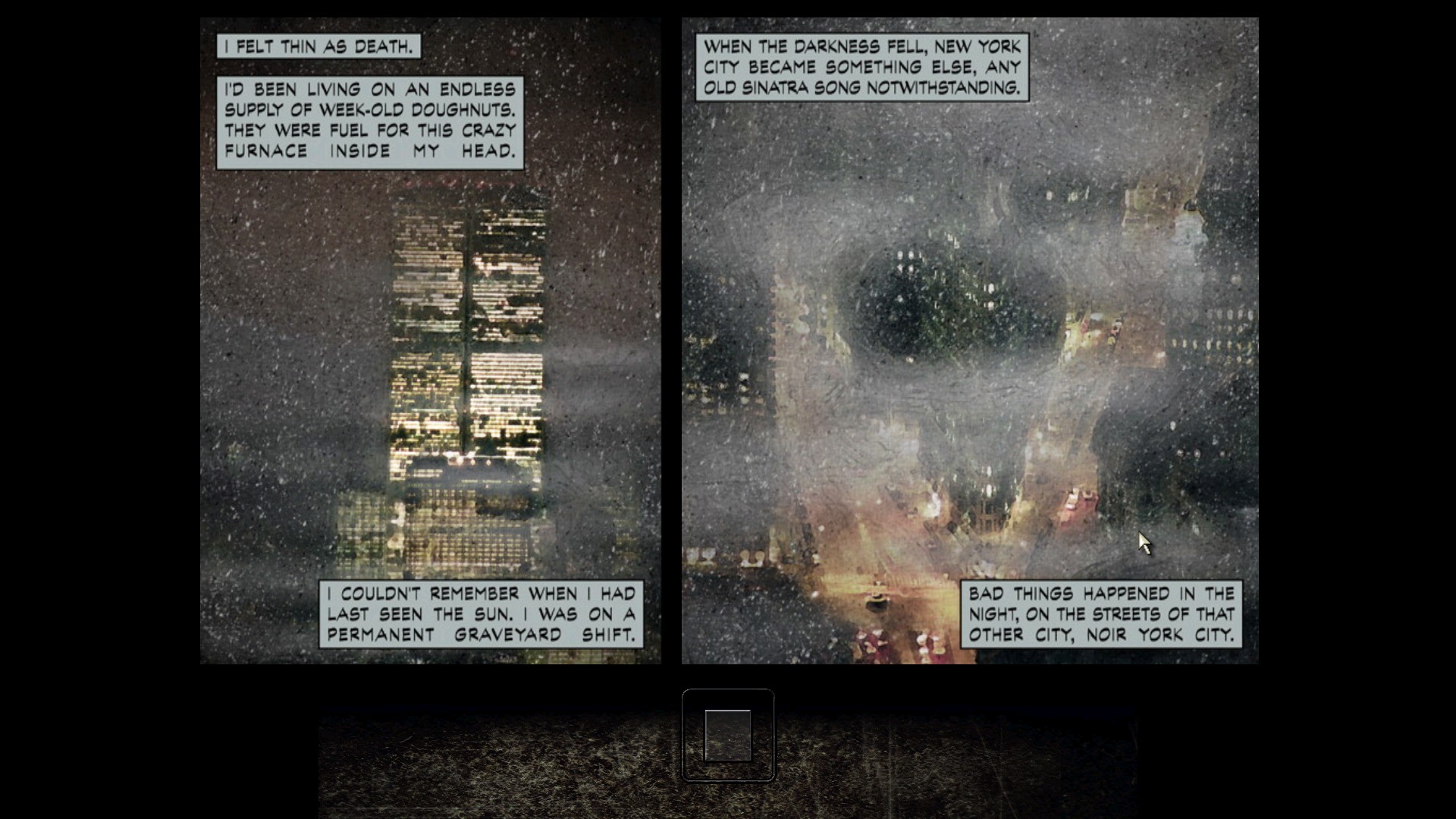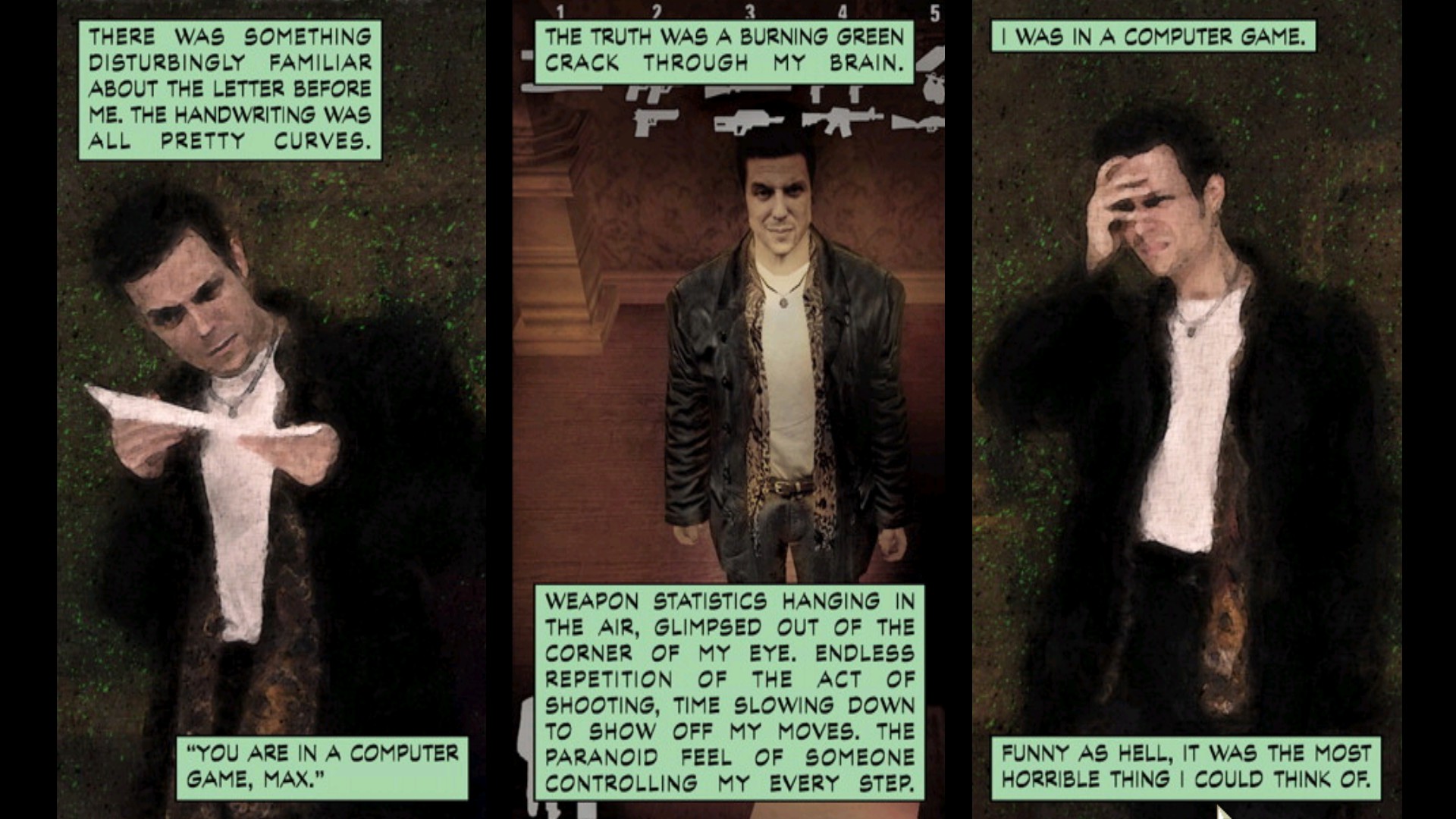Originally posted to Wordpress from July-August 2021
Introduction
Askeisk is a North Germanic conlang. It belongs to the West Scandinavian branch and is spoken on the (fictional) island of Askei, located halfway between Shetland and the Faroe Islands. It has around 5,000 speakers, many of whom are also bilingual in either Irish, Icelandic, or Norwegian.
Askeisk was primarily created for a story I was thinking about writing in 2016. That story is permanently on hold, but the conlang has managed to hold my interest for quite a long time.
Phonology
Askeisk's consonants are fairly similar to the other North Germanic languages. At one point, it included /ɬ/, /ð/, and /θ/, but I removed them as I didn't want to deal with too many fricatives. Like in Faroese and Iceland, stops contrast aspiration instead of voicing.
Askeisk's vowels are thoroughly uninteresting. Each vowel is either long or short. Short vowels exist in closed syllables (end with a consonant) and long vowels appear elsewhere.
Consonants
- Nasals: m n ɳ ɲ ŋ
- Stops: pʰ p tʰ t ʈʰ ʈ cʰ c kʰ k ʔ
- Fricatives: f v s ʃ ʂ ç h
- Approximants: l ɹ ɭ ɻ j
Certain consonants & consonant clusters have "soft" (palatalized) versions which only occur before front vowels. I created this rule before I decided on an aspiration rather than voicing distinction, which is really the only reason /g/ becomes [j] and not [c]:
- /k/ → [c]
- /g/ → [j]
- /h/ → [ç]
- /n/ → [ɲ]
- /sk/ → [ʃ]
Certain consonants followed by /j/ become palatalized:
- /nj/ → [ɲ]
- /hj/→ [ç]
- /gj/ → [j]
- /kj/ → [c]
- /tj/→ [ʃ]
- /sj/ → [ʃ]
All geminated, nonaspirated stops become preglottalized:
- /gg/ → [ʔk]
- /bb/ → [ʔp]
- /dd/ → [ʔt]
Meanwhile, geminated, aspirated stops become preaspirated:
- /kk/ → [hk]
- /pp/ → [hp]
- /tt/ → [ht]
Other misc sound changes:
- /nn/ → /tn/ → [ʔn̩]
- /ll/ → /tl/ →[ʔl̩]
- /gl/ → [ll]
- /skj/ → [ʃ]
Vowels
- Close: iː yː uː ɪ ʏ ʊ
- Mid: eː øː oː ɛ œ ɔ
- Open: æ æː a aː
At one point, every first-syllable /a/ was [æ]. I then decided that was obnoxious and made /æ/ its own independent phoneme.
There are quite a few possible diphthongs, but not all of them occur in actual words:
- aɪ aiː aʊ auː
- ɛɪ eiː
- ɔɪ oiː ɔʊ ouː
- œʏ øyː
- ʊɪ uiː
Stress
Like Norwegian and Swedish, Askeisk has a pitch accent! I guess at some point I decided I needed some kind of difference from Faroese and Icelandic, because I absolutely remember there being a stress system initially.
Monosyllables have no accent. Bisyllabic or longer words are pronounced with a rising tone on the first syllable.
Syllable Structure & Consonant Clusters
Askeisk's orthography isn't particularly strange, I think.
I'm including diphthongs & digraphs here because why not?
Orthography
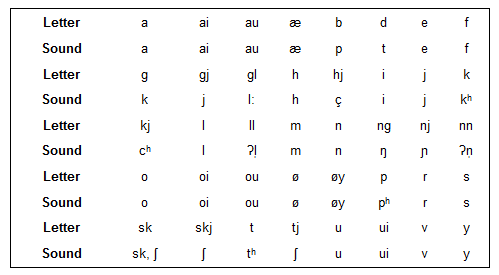
Grammar
Askeisk's grammar is pretty straightforward North Germanic. I did consider adding in some Irish influences, including some kind of initial consonant mutation, but I genuinely could not figure out how to make it work.
Nouns
Nouns have three cases (nominative, object, and genitive), two numbers (singular and plural) and three genders (masculine, feminine, and neuter).
The object case comes from the merger of the dative & accusative cases. For the most part, the object case declensions descend from the Old Norse dative declensions.
Nouns - Masculine
The masculine noun declension is basically identical to that of Old Norse:

Examples:
- fadir "father" → fadrinn, fedrar, fedrarnir
- hund "dog" → hundinn, hundar, hundarnir
- mauni "moon" → mauninn, maunir, maunarnir
- ørn "eagle" → ørninn, ernar, ernarnir
Nouns - Feminine
The masculine and feminine declensions were too similar at first. I spent a while thinking about how to distinguish them instead of collapsing them both into common like Danish and Swedish, and came up with something I think is fairly unique.
The plural declension of feminine nouns exclusively contain front vowels. This causes /u/, /o/, & /ou/ to front to /y/, /ø/, and /øy/. I took this from what happens to the feminine forms of adjectives, which is something I came up with long before I decided to do this.
Many other random back vowels get fronted, but...it's random. I don't think I decided on an actual pattern for it.

Examples:
- aska "ash" → askan, askær, askænæ
- douttir "daughter" → douttrin, døyttrær, døyttrænæ
- gaus "goose" → gausin, gæysær, gæysænæ
- ull "wool" → ullin, yllær, yllænæ
Nouns - Neuter
Neuter nouns are the same in the nominative plural and singular (except for some occasional vowel changes). I did nothing interesting with this declension.

Examples:
- barn "child" → barnit, børn, børnin
- egg "egg" → eggit, egg, eggin
- hus "house" → husit, hus, husin
- navn "name" → navnit, nøvn, navnin
Personal Pronouns
Askeisk's personal pronouns are nothing special. There are singular and plural versions, three genders in the third person, and possessive pronouns have different forms depending on the gender of the following noun.
Subject pronouns:
- 1st person: jeg, veir
- 2nd person: tu, eir
- 3rd person masculine: hann, teir
- 3rd person feminine: hon, tær
- 3rd person neuter: tad, tau
I decided to keep the distinction between the third person plural pronouns because collapsing everything into neuter seemed to be a little boring.
Object pronouns:
- 1st person: mig, oss
- 2nd person: tig, ydur
- 3rd person masculine: honum, teim
- 3rd person feminine: hen, teim
- 3rd person neuter: tad, teim
Here, the third person plural is the same in all genders, which it how it was in Old Norse.
Possessive pronouns:
- 1st person singular: minn, min, mitt, minar
- 1st person plural: vaur, vaurt, vaurar
- 2nd person singular: tinn, tin, titt, tinar
- 2nd person plural: ydar, ydart, ydarar
- 3rd person masculine singular: hans, hansar
- 3rd person feminine singular: henar, henrar
- 3rd person neuter singular: tess, tessar
- 3rd person plural: teirra, teirrat, teirrar
Only the 1st and 2nd person singular possessives distinguish between the masculine & feminine genders on the following noun. The 3rd person singular possessives don't distinguish gender at all, just number.
Here are some examples with 1st person possessives:
- køttinn minn "my cat"
- boukin min "my book"
- augat min "my eye"
- armarnir minar "my arms"
- eidinn vaur "our oath"
- husit vaurt "our house"
- beinin vaurar "our bones"
The third person possessive pronouns do not specifically refer to the subject or speaker; they can refer to absolutely anyone. Like with the other North Germanic languages, there is a separate set of reflexive pronouns - sinn, sin, sitt, sinar - which are used to clear up ambiguity:
- køttinn henar "her cat"
- køttinn sinn "her (own) cat"
"It"
Like the other pronouns, the Askeisk word for "it" is declined for case, number, and gender. The "default" form is tad.

Adjectives
Like you'd expect, adjectives take on the case, number, and gender of the noun they modify. Adjectives with /a/, /u/, and /au/ in the masculine (the default form of the adjective) become /ø/, /y/, and /øy/ in the feminine.
Examples:
- daud, døyd, daudt "dead"
- fraul, frøyl, frault "free"
- heit, heit, heitt "hot"
- redd, redd, reddt "afraid"
Adjectives can "agree" with 1st and 2nd person pronouns by matching the gender of the person:
- Jeg em glad. "I (male) am happy."
- Jeg em glød. "I (female) am happy."
- Jeg em gladt. "I (neuter) am happy."
- Tu ert glad. "You (male) am happy."
For the plural versions of the 1st and 2nd person pronouns, the neuter forms of adjectives are used by default:
- Veir eru gladt. "We are happy"
- Eir eru gladt. "You are happy".
Since adjectives have the same declensions as nouns, gladt is the same in the singular and plural numbers.
Comparatives & superlatives also have different forms depending on the gender of the adjective:

Determiners
Like in Swedish (and probably the other Scandinavian languages, but I don't know for sure since I've only studied Swedish), determiners are formed with a combination of tann "it" + heir/tar.
The proximal demonstratives "this/these" are:
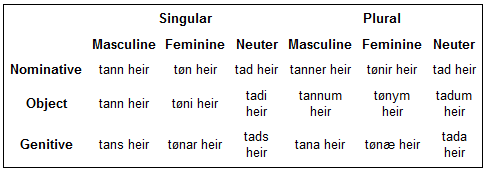
And the distal demonstratives "that/those":
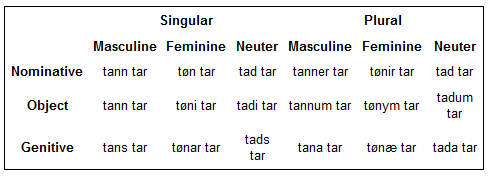
Examples
- Tann heir er køttrinn minn. "This is my cat."
- Tad tar epli eru raudt. "These apples are red."
- Tøn tar er døttrin sin. "That is her daughter.
- Tønir tar røydhakar eru smølær. "Those robins are small."
The Definite & Indefinite Articles
The definite article is suffixed to the noun. The indefinite article comes from the word einn meaning "one". It declines in the way any other noun does.
Verbs
Verbs are not nearly as complex as they are in Old Norse. I prefer to create highly regular conlangs, and there was a lot that was irregular in Old Norse. Still, this is supposed to be a naturalistic language, and natlangs have a lot of irregularity and redundancy built into them.
Verbs have four classes: strong, weak, preterite-present, and irregular. There is no subjunctive mood, primarily because I couldn't find enough examples of it on Wiktionary. That, and I didn't want to make more verb tables.
Verbs are marked for person (1st, 2nd, 3rd), number (singular, plural), tense (present, past), mood (indicative, imperative) and have infinitive, present & past participle forms.
Strong Verbs
In strong verbs, the past tense and participle are indicated with a vowel change. This happens for every single vowel:
- /a/ → /e/
- /au/ → /ei/
- /æ/ → /ø/
- /ei/ → /øy/
- /i/ → /ei/
- /o/ → /a/
- /ou/ → /au/
- /ø/ → /y/
- /u/ → /au/
- /y/ → /ø/
The present participle ends in -andi, past participle ends in -inn, singular imperative is the stem, and plural imperative ends in -id.
Indicative verb endings are shown in the table below:

Example: at falla "to fall"
- Present participle: fallandi
- Past participle: fellinn
- Imperative singular: fall
- Imperative plural: fallid

If a strong verb starts with the consonant /v/, then the first vowel in the past tense plural and past participle shift to /u/ while the initial /v/ is dropped.
Example: at verda "to become"
- Present participle: verdandi
- Past participle: urdinn
- Imperative singular: verd
- Imperative plural: verdid

Weak Verbs
Weak verbs have no vowel shift, only verb endings to indicate tense and person.
The present participle ends in -andi, past participle ends in -dur or -tur, singular imperative is the stem, and plural imperative ends in -id.
Indicative verb endings are shown in the table below:

Example: at læra "to learn"
- Present participle: lærandi
- Past participle: lærdur
- Imperative singular: lær
- Imperative plural: lærid

Preterite-Present Verbs
These are only a handful of verbs in this class, but they were interesting enough that I decided to keep them instead of putting them with the strong or weak verbs.
Present tenses are the same as strong verbs' past tenses, and past tenses are formed like weak verbs' past tenses. The participles are the same as weak verbs', the singular imperative is the stem, and the plural imperative ends in -ud.
Indicative verb endings are shown in the table below:

Example: at muna "to remember"
- Present participle: munandi
- Past participle: munadur
- Imperative singular: mun
- Imperative plural: munud

Irregular & Auxiliary Verbs
Askeisk only has a few irregular verbs. The most used is the copula, at vera "to be":
- Present participle: verandi
- Past participle: verit
- Imperative singular: ver
- Imperative plural: verid

Auxiliary verbs follow the same declension as weak verbs.
Passive Verbs
Passive verbs are formed by suffixing -sk to the verb form.
The Future Tense
Askeisk doesn't have a specific verb ending for the future tense. Most of the time, an auxiliary verb (munu, skulu, or vilja) is used in front of the bare infinitive form of the following verb.
Jeg munu fulgja tig. "I will (in the future) follow you."
Jeg skulu fylgja tig. "I will (must) follow you."
Jeg vilja fylgja tig. "I will (intend to) follow you."
A temporal adverb can be used with a present tense verb to indicate that an action occurs in the future:
Jeg fylgjir tig senn. "I'll follow you soon."
Negating Verbs
The adverb ekki "not" is used to negate verbs:
Jeg em ekki gladur. "I am not happy."
Tau er ekki fornt. "They are not old."
The Present & Past Perfects
The weak verb hava "to hold" can be used as an auxiliary verb when the following verb is in its supine form. The supine form is formed by suffixing the verb stem with -(a)t.
Jeg havi fylgjat tig. "I have followed you."
Jeg hava fylgjat tig. "I had followed you."
















